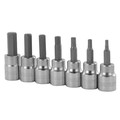Are both clutch cable ends of the soldered type on a '79 GS 550? (assume stock).
Oh and if Cliff reads this, thanks for hosting the clutch cable replacement guide (and all the other resources, of course).
Background:
I had trouble shifting gears intermittently for the last two days (flat out blocked) and first assumed something bent in the tranny, but during this morning commute it became clear what real issue is; the clutch cable had began to disintegrate (inner cable frayed at handlebar lever. classic.). After jury-rigging by adjusting for the increased slack, I barely made it to my workplace on the last three strings remaing (I think I arrived with two left. Gah...).
The replacement parts will take some time to arrive; but since I don't like to be bike-impaired until then (also, I scheduled my riding test very soon), I'd like to repair the whole thing in a temporary fashion. I do have some bicycle braking cables laying around, which use the same soldered cable end and the handlebar side. However, I'm not sure about the cable end on the clutch side. I'd need it to be a screwed type, since I'm not equipped for soldering the cable ends.
And yeah, of course I'll check the cable diameters first, though I don't expect the forces between disengaging a motorcycle clutch and applying bicycle brakes differ too much. (Of course, we're not talking about old ducatis, where you got a free workout each time you shifted gears).
I suspect the broken cable let the clutch engaged just enough to let the engine appear disconnected from the transmission, but still cause enough force on the gears to prevent me from switching when the gear's RPM's differed too much. I remembered that in the dark ages, transmissions were not synchronized, and one had to match the engine's RPM before shifting into gear (I never drove such equipment). When I was trying to mimic this, I had noticeably less trouble to switch gears (If somebody knowledgeable could confirm or refute this hypothesis, that'd be great).
.png)
 There are a _lot_ of red lights on the way. (getting into Neutral is already a minor hassle even with the clutch. That could be either me or the bike - more likely me).
There are a _lot_ of red lights on the way. (getting into Neutral is already a minor hassle even with the clutch. That could be either me or the bike - more likely me).

 Luckily, I was able to roll on the sidewalk, and do emergency maintenance...
Luckily, I was able to roll on the sidewalk, and do emergency maintenance...


 and redo the job because the new cable got loose, didn't tighten a screw enough. Went all Hulk on it, and yanked the s!%& out of the clutch on the next test drive. On the plus side, I'm now able to do the whole thing within 20minutes, that'll come in handy when doing a long journey and Murphy strikes. Also, I got to practice a bit of clutch-less shifting, like them graybeards.
and redo the job because the new cable got loose, didn't tighten a screw enough. Went all Hulk on it, and yanked the s!%& out of the clutch on the next test drive. On the plus side, I'm now able to do the whole thing within 20minutes, that'll come in handy when doing a long journey and Murphy strikes. Also, I got to practice a bit of clutch-less shifting, like them graybeards. 

Comment